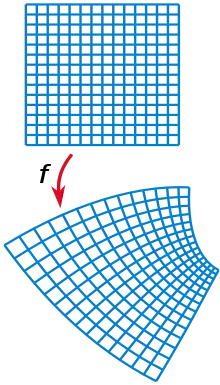
A (pseudo-)Riemannian manifold is conformally flat if each point has a neighborhood that can be mapped to flat space by a conformal transformation.
In practice, the metric of the manifold has to be conformal to the flat metric , i.e., the geodesics maintain in all points of the angles by moving from one to the other, as well as keeping the null geodesics unchanged,[1] that means there exists a function such that , where is known as the conformal factor and is a point on the manifold.
More formally, let be a pseudo-Riemannian manifold. Then is conformally flat if for each point in , there exists a neighborhood of and a smooth function defined on such that is flat (i.e. the curvature of vanishes on ). The function need not be defined on all of .
Some authors use the definition of locally conformally flat when referred to just some point on and reserve the definition of conformally flat for the case in which the relation is valid for all on .
Examples
- Every manifold with constant sectional curvature is conformally flat.
- Every 2-dimensional pseudo-Riemannian manifold is conformally flat.[1]
- The line element of the two dimensional spherical coordinates, like the one used in the geographic coordinate system,
- ,[2] has metric tensor and is not flat but with the stereographic projection can be mapped to a flat space using the conformal factor , where is the distance from the origin of the flat space,[3] obtaining
- .
- A 3-dimensional pseudo-Riemannian manifold is conformally flat if and only if the Cotton tensor vanishes.
- An n-dimensional pseudo-Riemannian manifold for n ≥ 4 is conformally flat if and only if the Weyl tensor vanishes.
- Every compact, simply connected, conformally Euclidean Riemannian manifold is conformally equivalent to the round sphere.[4]
- The stereographic projection provides a coordinate system for the sphere in which conformal flatness is explicit, as the metric is proportional to the flat one.
- In general relativity conformally flat manifolds can often be used, for example to describe Friedmann–Lemaître–Robertson–Walker metric.[5] However it was also shown that there are no conformally flat slices of the Kerr spacetime.[6]
- For example, the Kruskal-Szekeres coordinates have line element
- with metric tensor and so is not flat. But with the transformations and
- becomes
- with metric tensor ,
- which is the flat metric times the conformal factor .[7]
See also
References
- 1 2 Ray D'Inverno. "6.3 The Weil tensor". Introducing Einstein's Relativity. pp. 88–89.
- ↑ Spherical coordinate system - Integration and differentiation in spherical coordinates
- ↑ Stereographic projection - Properties. The Riemann's formula
- ↑ Kuiper, N. H. (1949). "On conformally flat spaces in the large". Annals of Mathematics. 50 (4): 916–924. doi:10.2307/1969587. JSTOR 1969587.
- ↑ Garecki, Janusz (2008). "On Energy of the Friedman Universes in Conformally Flat Coordinates". Acta Physica Polonica B. 39 (4): 781–797. arXiv:0708.2783. Bibcode:2008AcPPB..39..781G.
- ↑ Garat, Alcides; Price, Richard H. (2000-05-18). "Nonexistence of conformally flat slices of the Kerr spacetime". Physical Review D. 61 (12): 124011. arXiv:gr-qc/0002013. Bibcode:2000PhRvD..61l4011G. doi:10.1103/PhysRevD.61.124011. ISSN 0556-2821. S2CID 119452751.
- ↑ Ray D'Inverno. "17.2 The Kruskal solution". Introducing Einstein's Relativity. pp. 230–231.